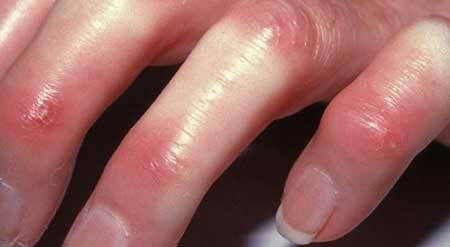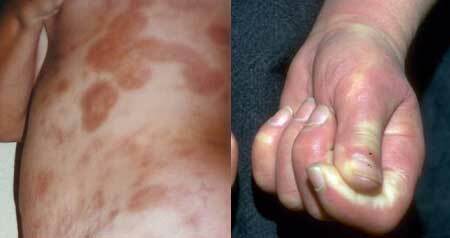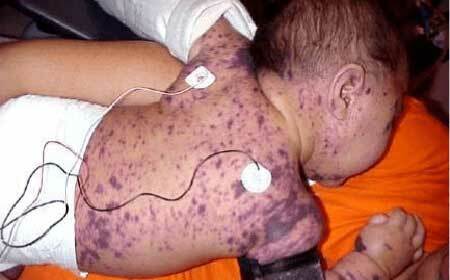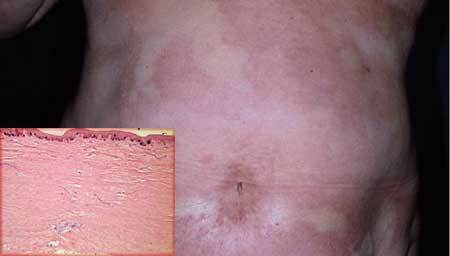What is it?
Scleroderma is a chronic, progressive disease of connective tissue that is characterized by its hardening, compacting and scarring.
If focal scleroderma can not be stopped, the disease can go into a systemic form, and then the connective tissue will grow pathologically in muscles and internal organs. The most common system scleroderma in the heart, kidneys, stomach, intestines and lungs.
Contents
- 1 The causes of scleroderma and the development of the disease
- 2 Symptoms of scleroderma, photos
- 3 Focal scleroderma - symptoms and types
- 4 Systemic scleroderma - symptoms, first signs
- 5 Scleroderma treatment, preparations
- 5.1 Scleroderma prognosis
Scleroderma causes and development of the disease

Scleroderma, photo 1

photo 2
Causes of the disease have not yet been studied, but the mechanism of tissue damage to specialists is clear. After the violation of the functions of fibroblasts, collagen is produced in volumes with which the body can not cope, and the type that is typical for this or that organ is synthesized, and pathological.
The response of an autoimmune system is the rejection and attack of one's own tissues - this mechanism leads to a modification and consolidation of the connective veils. This means that the immune system is trying to get rid of pathological collagen, but this provokes an inflammatory response in the organs. Such processes can be caused by:
- constant stress situations;
- by regular supercooling of the body;
- transfer of acute infections;
- by neglected long-term chronic diseases;
- by irradiation and chemotherapy;
- long-term intake of aggressive medications;
- by introducing into the body of substandard vaccines with a high allergic potential;
- blood transfusion and organ transplant;
- hormonal changes during pregnancy, puberty or menopause.
If you understand the mechanism of scleroderma development in more detail, then the following occurs: the endocrine system produces a lot of serotonin, which causes vasospasm. At the same time, the links between hyaluronidase and hyaluronic acid are violated. In the connective tissue there is accumulation of monosaccharides, the connective tissue "degrades", and the synthesis of collagen is not limited in any way.
Scleroderma disease affects every element of connective tissue, so get rid of it so hard. Elastin and collagen fibers, end points of vessels, capillaries, nerve endings, as well as interstitial cells and a sticking agent, are affected.
The whole mechanism affects the composition of the blood in the form of a disparity of leukocytes and protein occurrences. As a result, a vicious circle can not be broken-it closes.
According to statistics, women face scleroderma four times more often than men. The predisposition is also due to the climate and even the race - most of the cases of the disease were found among the population of Africa and Northern India( most likely, this is due to an increased level of insolation).The age of a person does not affect the probability of developing scleroderma.
Symptoms of scleroderma, photos
Symptoms differ depending on the form of scleroderma. Some symptoms can behave as separate diseases, and even give in to local treatment. However, there are several common manifestations of scleroderma for all forms:
- Skin modification. The most common lesions of the limbs and face. The skin is stretched excessively, because of this, a characteristic shine appears. There is swelling in the phalanx and between the fingers. Skin changes and swelling occur around the hands and around the lips. Movements can become painful and difficult.
- Raynaud's syndrome is the defeat of the limbs in response to cold weather or stress. Small vessels become hypersensitive to the temperature and impulses of the nervous system, so the fingers or even the palms go numb against the background of vasospasm( a decrease in the diameter of the vessels).Against the background of a chronic course, the color of the hands and feet changes, pains in the limbs, tingling and itching can be observed.
- GERD is a gastroesophageal reflux disease associated with dysfunction and thickening of the esophagus and damage to its muscular sphincter. There is damage to the walls due to increased acidity and eructations. Peristalsis of the stomach is broken, so digestion of food becomes difficult. There are problems with the absorption of microelements and vitamins through the walls of the gastrointestinal tract. Because of GERD, there may be an avitaminosis and minor hormonal failures.
Focal scleroderma - symptoms and types

Focal scleroderma photo 3

photo 4 - scleroderma in children
It is also called localized and has a medical code: L94 scleroderma μB-10.It has several subspecies, the symptoms of which are different.
- Plaque( limited) scleroderma
This form of scleroderma got its name due to the formation of plaques on the skin with clearly defined edges with a rim of lilac or bluish color.
The size of the spots can vary from 2 to 15 cm. The plaque itself is gray or yellowish, has a smooth, glossy surface and can be above or below the overall skin level. The shape of the spots can be any shape;an oval, a circle, a line, and they are located on the limbs, trunk and face, can be present on the hairline.
Symptomatic plaque scleroderma differs in its different stages. From the beginning on the spot of the alleged spot, edema develops, and the skin becomes dense, soft and stretched. The plaque acquires a violet-red hue and has a shape close to the circumference.
After a few weeks, the skin begins to harden, the plaque begins to resemble wax consistency. The junction of the plaque and intact skin is very dense and sharply delineated. The hair on the plaque falls out, and it can acquire any shape. The skin completely loses its elasticity, so the second stage of plaque scleroderma is called collagen hypertrophy.
The third stage is characterized by atrophy of the skin in place of the plaque. Visually the skin becomes as thin as possible, however it is not as vulnerable as it seems. In size, the stain can not change more.
By the third stage, the plaque often takes the form of an oval or ribbon, however, a sparse pattern of a spiral, bubble, or ring is also found.
- Ribbon scleroderma.
It can be present only in several parts of the human body( ie has a favorite localization): from the scalp above the forehead to the tip of the nose, the vertical band on the chest and the line along the nerve trunk( Ged zone).
The strip is reminiscent of a stab from a knife. The ribbon-shaped form of scleroderma indicates that the neurotrophic pathogenesis of the disease has taken place - scleroderma moves to nerve fibers. Otherwise, the disease precedes atrophy of half of the face in young children.
- Disease of "white spots"
Small white spots, up to 1 cm in diameter, may appear on the shoulders, neck, chest, genitals and in the oral cavity. Often spots are located in small groups, each of them clearly outlined by a red-brown rim.
They have a waxy, glossy surface, but their color is necessarily lighter than the skin or mucous membranes. Spots can rise or fall under the skin, which helps distinguish them from fungal diseases, for example, depriving.
- Superficial scleroderma
The easiest form of scleroderma, due to which on the back and lower limbs appear small plaques of gray-brownish hue. They practically do not progress, but they do not have clear edges.
The center of such a plaque is below the level of the underlying skin. The skin in the middle of the stain becomes so thin, so you can even consider small vessels.
Systemic scleroderma - symptoms, the first signs of

photo 5 - symptoms of systemic scleroderma
The full medical name is: systemic diffuse progressive, generalized scleroderma. This form of the disease is very severe, it gradually spreads to all tissues of the body, affecting the internal organs.
As a rule, the first signs of systemic scleroderma appear in girls during adolescence and are associated with hormonal changes in the puberty period. Much less often the disease begins in childhood and affects the male sex.
There are several common symptoms of systemic scleroderma:
- plaques on the face and hands, and then on the trunk and extremities;
- yellowing spots, waxy skin, loss of elasticity and sensitivity;
- vasodilation on affected areas;
- skin on plaques is strained, limb movement is limited, mimicry on the face is impossible;
- sharpening of the nose, reduction and narrowing of the mouth;
- enlarged lymph nodes in the groin and underarms;
- insomnia;
- pain along the way of nerve endings;
- sensation of numbness and stiffness of the skin;
- weakness, headache, fever;
- pain in muscles and joints;
- appearance under the skin of small calcareous nodules, which can behave like ulcers - calcification( it is associated with the deposition of calcium salts, which are easily attached to pathologically altered collagen).Calcium can lead to the most unpleasant and irreversible consequences. The tips of the fingers on the legs and hands are sharpened, this leads to their dysfunction and, consequently, atrophy. The tendons become thin, and the tone of the joints disappears.
The walls of the mucous membranes in the gastrointestinal tract, pharynx, larynx and oral cavity are also affected: they become dry and wrinkled, bringing discomfort when eating. There are transformations of the soft palate, in particular the tongue, which makes swallowing much more difficult.
In the pathological process, the language is sometimes involved, and this leads to speech disturbance. Thus, the clinical symptomatology of systemic scleroderma is very diverse.
The most dangerous for the diagnosis of the manifestation of scleroderma is the case when the lesions of the internal organs: kidneys, heart, liver and stomach, occur earlier than on the skin appear plaques or spots.
At the beginning of the development of the disease, typical signs in medical research are very difficult to identify. Determine in the serum of blood, patients with antiplasmic bodies can only at the stage of plaques.
Treatment of scleroderma, preparations
If the patient has focal scleroderma, the treatment is prescribed as intramuscular injections of the preparation hyaluronidase( an enzyme preparation showing tropism to connective tissue fibers).Lidase( another enzyme) can also be injected directly into places of plaques and spots with the help of ultrasound and electrophoresis.
Additionally, drugs that expand the vessels and stimulate microcirculation in the tissues can be prescribed: an andecamine, nicogipan, kallikrein.
If the treatment of scleroderma occurs already at the stage of compaction, injections with strong antibiotics of the penicillin group are used. In complex therapy, vitamins of group A, B15, B and C are also prescribed, they contribute to the recovery of the affected skin after stimulation with antibiotics.
Sometimes a dermatologist or infectious diseases prescribes hormone therapy, within which the patient takes a thyroidin or estradiol benzoate.
In very rare cases, the patient is prescribed an antimalarial drug: plakvenil or hingamin, which stop the progressive proliferation of connective tissue.
If the patient has systemic scleroderma, intravenous injections of low molecular weight dextran are used. The percentage of plasma increases, the blood becomes more fluid and circulates more actively.
In the complex, physiotherapy is prescribed in the form of electrophoresis, ultrasound, Bernard's diadynamic currents and paraffin and ozocerite applications. The patient uses mud and hydrogen sulphide baths, massage, therapeutic gymnastics.
Prognosis for scleroderma
Determining how dangerous scleroderma is, what it is and how to treat such a disease, doctors make a prediction for a specific patient. Focal scleroderma often successfully treated, and in the future the quality of life of the patient does not suffer.
The prognosis for the systemic form is purely individual, as the disease progresses slowly and for a very long period. In 80% of cases the patient's life is safe, very rarely possible deaths.



